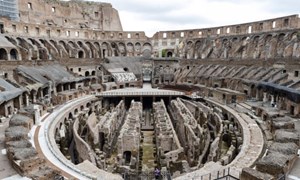
The ancient Roman Colosseum is once again going to have a floor thanks to a new, hi-tech project announced by the culture ministry on Sunday.
The ancient Roman Colosseum is once again going to have a floor thanks to a new, hi-tech project announced by the culture ministry on Sunday.
"It is an extraordinary project," said Culture Minister Dario Franceschini, detailing the plans to create a flexible floor to give tourists a clearer idea of how the arena would have looked when gladiators fought to the death there. "You will be able to walk on it and go to the centre of the Colosseum, seeing it in the same way as visitors used to up to the end of the 19th century," Franceschini said.
The Roman amphitheatre, completed under Emperor Titus in AD80, once had a wooden floor covered with sand that was built on top of a network of tunnels and rooms where gladiators and animals waited before entering the arena. The last floor was removed by archaeologists to get a better glimpse of the labyrinth of rooms and corridors that lay below the arena. It was never fully replaced.
Italian engineering firm, Milan Ingegneria, won the 18.5 million-euro ($22.2 million) contract to design the new flooring and has committed to complete the project by 2023. The wooden platform will be made up of hundreds of slats that can be rotated to bring natural light into the underground chambers that once used to house the gladiators and animals before their deadly combat.
The Colosseum is Italy's most popular tourist attraction, drawing some 7.6 million visitors in 2019, before the coronavirus struck.
The stone arena was the biggest amphitheatre in the Roman empire. It used to have up to 70,000 seats and hosted gladiator fights, executions and animal hunts. It could also be filled with water to re-enact sea battles.

ArtDependence Magazine is an international magazine covering all spheres of contemporary art, as well as modern and classical art.
ArtDependence features the latest art news, highlighting interviews with today’s most influential artists, galleries, curators, collectors, fair directors and individuals at the axis of the arts.
The magazine also covers series of articles and reviews on critical art events, new publications and other foremost happenings in the art world.
If you would like to submit events or editorial content to ArtDependence Magazine, please feel free to reach the magazine via the contact page.